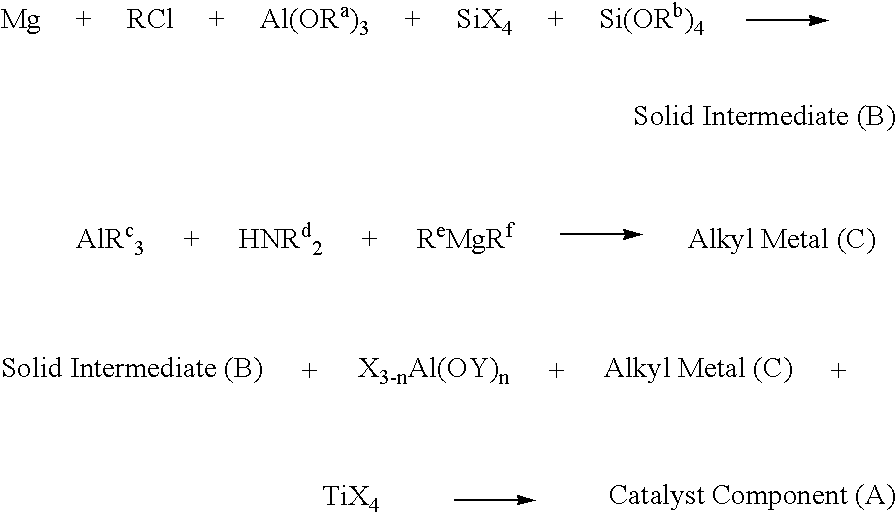Catalyst system for producing ethylene (co) polymer with improved branch distribution
a technology of ethylene polymer and catalyst system, which is applied in the field of catalyst system, can solve the problems of slow development of such system in gas phase process for producing lldpe, affecting the applicability of such system, and affecting the application of catalysts in existing plants. , to achieve the effect of improving the compositional distribution of branching
- Summary
- Abstract
- Description
- Claims
- Application Information
AI Technical Summary
Benefits of technology
Problems solved by technology
Method used
Image
Examples
example 1
Preparation of Solid Intermediate (B)
[0049]Magnesium powder (31.3 g), hexane (2 liter), and of iodine (2.2 g) were introduced successively into 5-liter reactor, and 1.2 ml isobutanol, 2.8 ml n-BuCl, and 15 ml of tri(sec-butoxy)aluminum were added. The mixture was heated with stirring to 85° C. and maintained stirring for 30 minutes. Then lowered temperature to 80° C. and when the temperature reached 80° C., rapidly added 15 ml tetraorthosilicate (Si(OEt)4) and 50 ml of silicon tetrachloride, and followed by slow introduction of 200 ml of n-butylchloride over 4 hours. Following the addition of n-butylchloride, the reaction mixture was stirred at 80° C. for 2 more hours and then cooled to room temperature (30° C.). The resulting precipitate was triply washed with 2000 mL hexane to obtain the solid intermediate (B).
Preparation Catalyst Component (A).
[0050]A hexane solution of triethylaluminum (160 mmol) was placed in 1000 mL flask and dicyclohexylamine (160 mmol) was added slowly over ...
example 2
Preparation of Solid Intermediate (B)
[0055]Solid intermediate (B) was prepared with the same method described in Example 1 except Si(OEt)4 was not added.
Preparation Catalyst Component (A)
[0056]A hexane solution of triethylaluminum (160 mmol) was placed in 1000 mL flask and dicyclohexylamine (160 mmol) was added slowly over 30 minutes and stirred for 1 hour to yield a pale yellow solution. Then, butyloctylmagnesium(BOM) solution in heptane (80 mmol) was added and stirred for another 30 minutes to prepare alkyl metal(C).
[0057]To the solid intermediate prepared above, 120 mmol of tri(sec-butoxy)aluminum was added with 1000 ml hexane and after 20 min. stirring at room temperature, alkyl metal (C) solution prepared above was added and stirred for another 50 min. Then, 15 ml of tetraorthosilicate (Si(OEt)4) was added and after stirring for 30 min., 20 ml of titanium tetrachloride(TiCl4) was added and stirred for 2 hours. The solid was washed three times to get catalyst component (A). Anal...
examples 3-5
[0059]Preparation of Solid intermediate (B) and Catalyst Component (A) were prepared in the same method described in Example 1, except Si(OEt)4 amount was changed as listed below.
Example 3Example 4Example 5Si(OEt)4 added3 ml8 ml15 ml
Ethylene Polymerization and Gas Phase Co-Polymerization
[0060]Polymerization was done in the same manner as Example 1 and gas phase polymerization results are listed in Table 1.
PUM
| Property | Measurement | Unit |
|---|---|---|
| density | aaaaa | aaaaa |
| density | aaaaa | aaaaa |
| molecular weight distribution | aaaaa | aaaaa |
Abstract
Description
Claims
Application Information
 Login to View More
Login to View More - R&D
- Intellectual Property
- Life Sciences
- Materials
- Tech Scout
- Unparalleled Data Quality
- Higher Quality Content
- 60% Fewer Hallucinations
Browse by: Latest US Patents, China's latest patents, Technical Efficacy Thesaurus, Application Domain, Technology Topic, Popular Technical Reports.
© 2025 PatSnap. All rights reserved.Legal|Privacy policy|Modern Slavery Act Transparency Statement|Sitemap|About US| Contact US: help@patsnap.com

